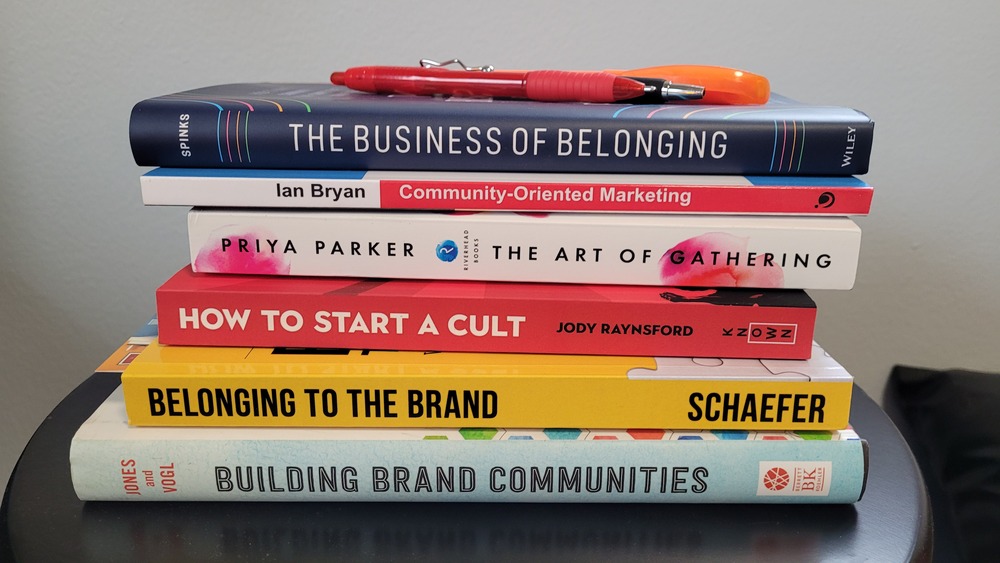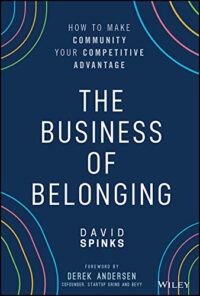Lately, I’ve been diving into the world of community building. While many companies, especially in the tech industry, have had Community Managers on their payrolls for years, this role has historically been viewed as having a customer support function. It’s only in the last few years that companies have realized that brand communities have positive impacts on every aspect of the business, from product development to employee recruitment to marketing. With this realization has come an increasing amount of literature on the topic. Here are the books that are currently on my night stand:

In the broadcasting industry, we do not have Community Managers. That’s because radio stations don’t build communities; they attract audiences, and audiences and communities are not the same thing. Here’s an explanation of the difference between the two.
Nonetheless, I am finding a lot of principles in the community-building literature that radio stations can put into practice. For example, a few weeks ago, I wrote about the difference between prizes that try to bribe people to listen and prizes that recognize people for listening. I singled out the prize that NPR’s Wait Wait…Don’t Tell Me! gives away, a voicemail greeting recorded by one of the show’s celebrity judges. Wait Wait‘s Doug Berman pointed out that “winning it, and even wanting it, made you part of our club” (emphasis mine).
When I asked my readers to tell me about prizes that their stations give away which are similarly “worthless but priceless,” I received a wide range of creative answers, including everything from participation trophies to bits of concrete. The lesson is that listeners can find a lot value in inexpensive but meaningful symbols of appreciation. Many of these symbols come in a form that radio stations call “swag,” including T-shirts, stickers, and coffee mugs.
What Radio Gets Wrong About Swag
I thought I had exhausted this topic until I ran across this passage in David Spinks‘ 2021 book, The Business of Belonging:

Swag is obviously a popular reward. Giving your members a comfy T-shirt, a mug, a sticker for their laptop, or something else representing your community can be effective if that person genuinely cares about your brand.
I find that a lot of companies think about swag in the wrong way. Too often, companies just slap their logo on a T-shirt and hope that their members will wear it around and spread awareness of the brand. In reality, you just gave them a really comfortable pajama shirt that will likely never leave the house.
Instead of thinking about swag as a billboard, focus on how the swag will make the member feel when they wear or see it. It doesn’t even have to have your logo, as long as they remember that it’s a representation of your community, and a reminder of a positive experience. A beautifully designed piece of swag that people actually want can be more effective at reinforcing their sense of identity as a member, even if your logo doesn’t show up anywhere. (page 105)
These days, many radio stations have gotten out of the swag business entirely. Record labels aren’t as apt to foot the bill for this stuff as they used to be, and as radio stations look for line items to cut from their budgets, it’s easy to nix the swag. After all, the swag doesn’t appear to be a very cost-effective marketing technique.
But what if Spinks is right? What if the value of swag isn’t in attracting new fans, but in thanking existing fans? Put another way: The power of swag doesn’t lie in cume-building; it’s in retaining P1 listeners. Suddenly, axing swag from the budget looks like a big mistake.
Swag Reinforces People’s Social Identities
Spinks dedicates an entire chapter of his book to “Creating a Social Identity.” He says:
Humans form much of our personal identities around the shared identities of the groups we participate in. We adopt the beliefs, styles, language, symbols, rituals, and other forms of expression that exist within the groups we’re a part of. (page 55)
While Spinks is talking about communities, not audiences, this principle can also be applied to fans of a brand. We often display our affinity for particular brands because we think it says something about ourselves. When you see people associating themselves with these brands, what message are they trying to convey?
- Harley-Davidson
- Louis Vuitton
- CrossFit
- Ben & Jerry’s
- The North Face
- Apple
- Lululemon
- Hennessy
- Lexus
- HubSpot
Not all products send strong messages to other people about social identities. When I order a local craft beer at a bar instead of a Budweiser, I am sending a message to others; when I buy paper towels at the grocery store, I am not. But for many years, associating yourself with a radio brand has been a great way to tell others about yourself. Think about the messages people are conveying when they let you know that they listen to these audio brands:
- Hot 97 (New York City)
- KSHE (St. Louis)
- KEXP (Seattle)
- WFAN (New York City)
- Magic 102.3 (Washington D.C.)
- NPR
- K-Love
- BBC
- The Bobby Bones Show
- Comedy Bang! Bang!
- Pod Save America
- Rush Limbaugh
When I see somebody showing their connection to one of these brands — through a keychain, a coffee mug, a screensaver, etc. — I instantly know something about how they perceive themselves. They aren’t displaying their affinity for these brands because they want to tell me about the brands; they are displaying it because they want to tell me about themselves.
When we stop giving our listeners swag, we force them to find other ways to tell people about themselves. Instead of using radio stations to convey their social identities, they will do it through the TV shows they watch or the sports teams they root for or the cars they drive. This will strengthen their ties to those brands and weaken their ties to ours. When radio stops being a social identity signifier, it hurts our entire industry; we become more like paper towels and less like beer brands. After all, there’s a big difference between listening to a radio station because “I like the music they play” and “It’s who I am.” The latter is far more powerful.
The point of radio station swag isn’t to attract new listeners; it’s to strengthen your bond with your most passionate existing listeners. It has value even if the recipient never shows the swag to anyone else. But if they do show it to other people, it’s a happy byproduct that illustrates just how strong your connection to that fan is.
Other prizes can’t do that. So maybe radio stations should worry less about bribing listeners with cash and concert tickets, and focus more on stickers and shirts. There’s power in swag.
- A Simple Digital Treat to Thank Your Radio Listeners This Thanksgiving - November 13, 2023
- Interview Questions When Hiring Your Radio Station’s Next Digital Marketing Manager - November 6, 2023
- A Radio Conversation with ChatGPT: Part 2 – Promotions - October 30, 2023





Playing catch-up on the blogs. (An unexpected hospitalization has thrown me behind. I highly recommend against it.)
I love the line that seeing someone’s swag tells you more about THEM, than about the brand on the swag. You can tell me any number of facts about yourself but tell me your favorite radio station in town and I’ll instantly know more about YOU than just the sum details of your life.
And if someone cares enough about you to even have your swag to begin with–even if it’s not carried outside the home–shouldn’t we have the sense and decency to make sure that person knows we care about them?
Or would we rather wait until someone else steps in and tells them?
Hope you’re OK. Thanks for the note. Feel good!
Thanks, Fred. Appreciate it. Turned out to be some severe bacterial infection. Fortunately I went in when I did, last Sunday, and didn’t wait til Monday. Thank God it was treatable but had I waited it could have spread to organs (it did infect one–bad enough) and turned into something much more serious. Nothing like a little health scare to give you some perspective–and a nice dose of thanksgiving FOR your health. So I’ll turn it back on you and say be well, my friend you “feel good,” too!
This is spot on. Also, it helps to be an iconic station with a cool logo.
It definitely does! Thanks, Garett!